Ian Crawford reviews the 2018 Mazda CX-8 Sport FWD with pricing, specs, ride and handling, safety, verdict and everything the over-50 driver needs to know.
Summary: Mazda has found another micro-niche, squeezing in an SUV model between the CX-5 and the CX-9.
2018 Mazda CX-8 Sport FWD
Pricing: From $42,490 (plus on road costs) (but it’s a big jump in price to the upper spec AWD Asaki model)
Warranty: Five years, unlimited km (yet another company comes on board with a longer warranty)
Safety: Five-star ANCAP (date stamp 2018)
Engine: 2.2-litre four-cylinder diesel
Power: 140kW @ 4500rpm (pretty much par for the category)
Torque: 450Nm @ 2000rpm (good torque from low revs)
Transmission: Six-speed sports automatic
Drive: Front-wheel drive (Sport), all-wheel drive (optional on Sport, standard on Asaki)
Body: 4900mm (long); 1840mm (wide); 1720mm (high) (fits right between the CX-5 and CX-9)
Turning circle: 11.6m
Kerb weight: 1957kg (not too heavy, not too light)
Towing: 2000kg (braked), 750kg (unbraked)
Maximum towball download: not stated
Spare: Space saver (the CX-8 won’t stray far from the bitumen, so probably not an issue)
Fuel Tank: 74 litres (a theoretical range better than 1000km)
Thirst: 5.7L/100km (combined, FWD) 6.0L/100km (combined, AWD)
Fuel type: Diesel (diesel is the preferred engine for larger SUVs, so a welcome addition)
seniordriver consumption: 5.7L/100km (yes, we managed the same figure as the official reading)
[review]
Mazda’s new CX-8 is the Japanese brand’s long-awaited large seven-seat turbo-diesel SUV and it slots in the SUV model pecking order between the hot-selling CX-5 mid-sizer and the big CX-9.
While the CX-9 has been around since 2008, Mazda was a “Johnny-come-lately” into the large SUV segment and it was a car with under-the-bonnet shortcomings.
First, its V6 petrol engine was as thirsty as a drover after a hard day pushing cattle down the long paddock in the blazing summer sun (and that has to be a consideration if you’re planning to hook up a caravan and take off around Australia) and secondly, there was no turbo-diesel on offer, which in this category is a cardinal sin.
Mazda fixed the first part of that in July 2016 when it replaced the V6 with an excellent turbo-charged 2.5-litre petrol engine that adopts all of the company’s best technology to deliver diesel-like torque.
Late last year the CX-9 was upgraded again with improvements that were evolutionary rather than revolutionary but the petrol engine remained the only powerplant on offer.
A further upgrade a couple of months ago improved things even more.
While petrol is still the fuel for the big Mazda, it is interesting that the slightly smaller new CX-8 is diesel-only vehicle that comes in just two variants – Sport and Asaki.
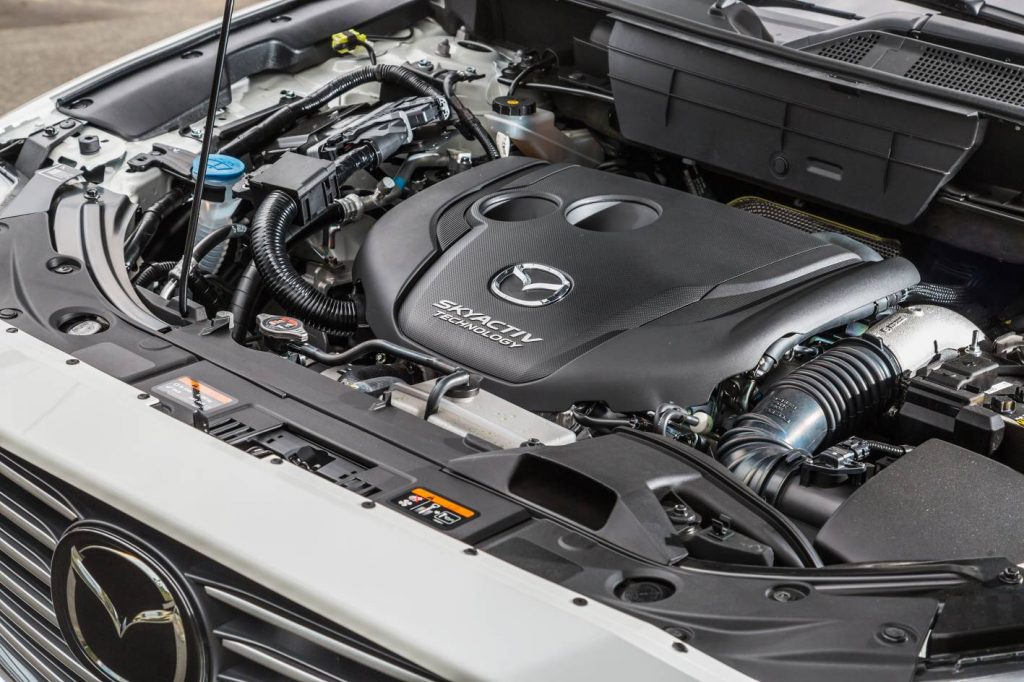
Finally, the diesel engine buyers want.
The engine is the one we first encountered in the CX-5 and it’s a 2.2-litre Skyactive-D four-cylinder turbo-diesel that blesses the new CX-8 with 140kW of power at 4500rpm and a thumping 450Nm of torque at a relaxed 2000rpm.
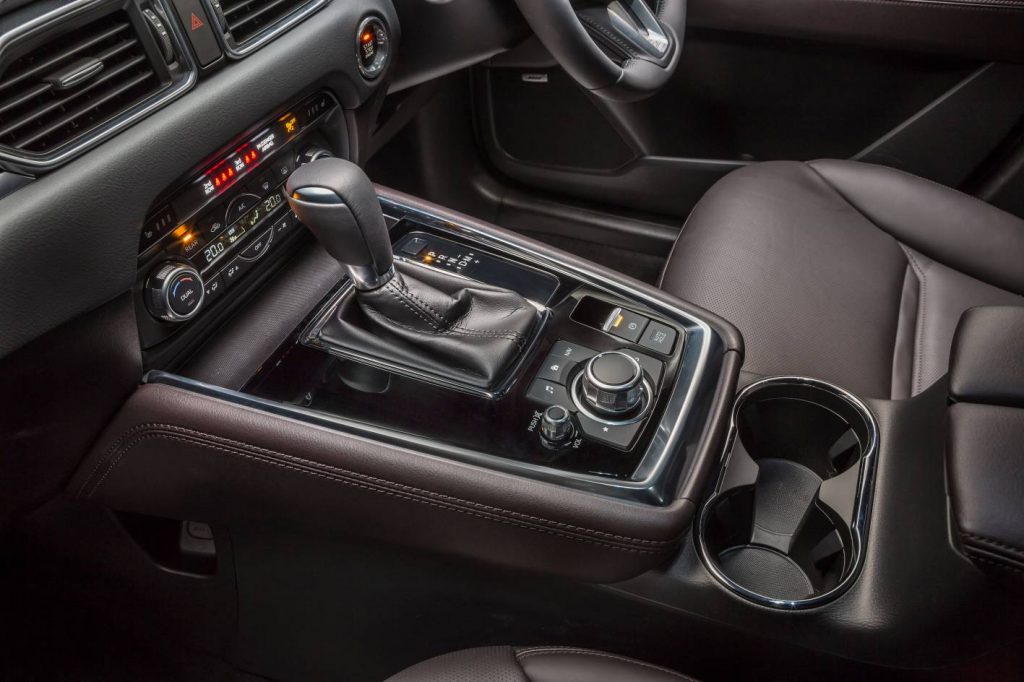
Transmission is via a smooth-shifting six-speed torque-converter automatic and there are no paddle shifters, you can shift manually via the console-mounted shifter.
Mazda claims a best-in-class combined-fuel-consumption figure of just 5.7L/100km … a figure I saw constantly during my week with the car.
At first glance the CX-8 could be a CX-9, probably because it rides on the same 2930mm wheelbase as the bigger unit.
The CX-8 is however 175mm shorter, 129mm narrower (the same as the CX-5) and it is set 17mm lower than its big brother.
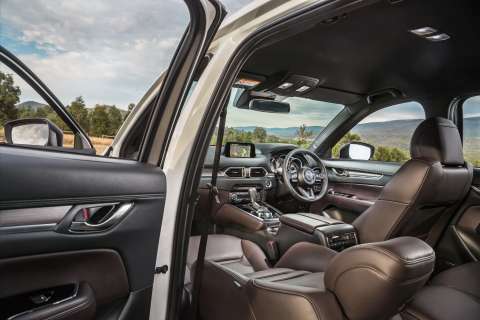
The Sport model will be the big seller
For this test, the entry-level front-wheel-drive Sport was the weapon of choice, and given that Mazda expects it to command 60 percent of the new SUV’s sales, that was the way to go.
The test car comes in at $42,490 plus on-road costs – a figure that means it is $2500 dearer than the least-expensive CX-5 diesel, but $1400 cheaper than its entry-level CX-9 big brother.
Opt for a four-paw Sport and it’ll cost you another $4000 but if you want the one-with-the-lot AWD Asaki you’re up for $61,490. That’s a big jump up from the front-wheel drive headliner.
One other bit of good news for Mazda buyers is that finally, the company has announced a five-year unlimited kilometre warranty … still two years short of Kia’s industry-best version but up there with many of the others, including Hyundai, Ford and Holden.
The new CX-8 comes standard with of Mazda’s i-ACTIVESENSE safety features and they include blind-spot monitoring, high-beam control, intelligent speed assistance, a lane-keep-assist system, lane-departure warning, radar cruise control with stop-and-go function, rear cross-traffic alert, smart forward-and-reverse city-brake support, traffic-sign recognition, a reverse camera and rear parking sensors.
Not too shabby for an entry-level variant.
Also on the standard-kit menu for the CX-8 Sport are 17-inch alloy wheels shod with 225/65 rubber, cloth trim, the seven-inch MZD Connect infotainment system, automatic LED headlights, windscreen-projected head-up display, three-zone air-conditioning, a six-speaker audio system with a DAB+ digital radio, Bluetooth connectivity and satellite navigation.
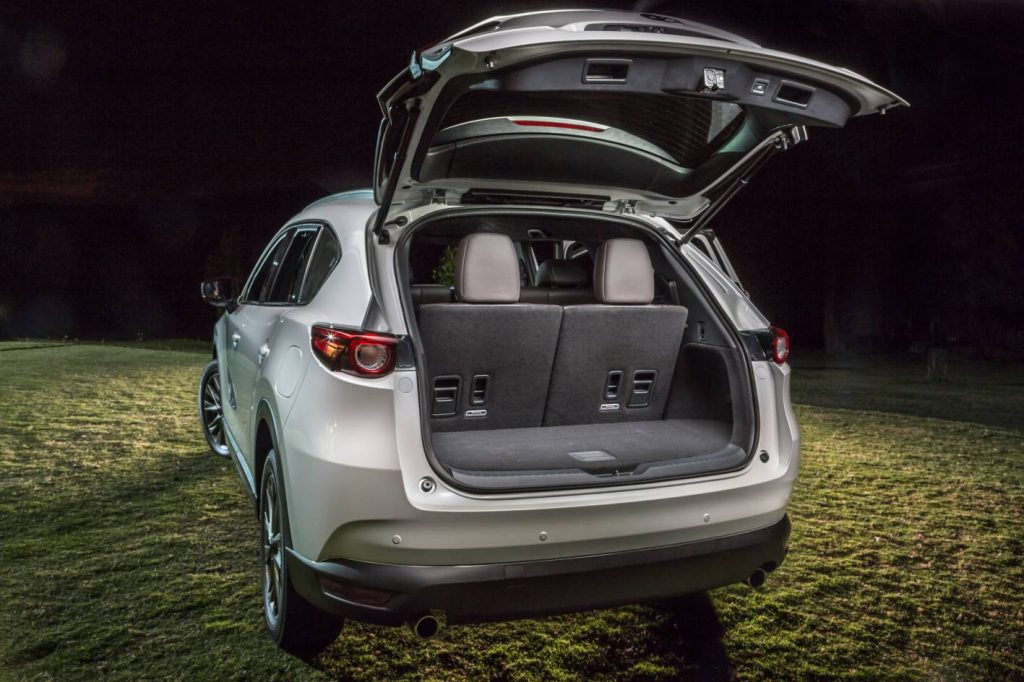
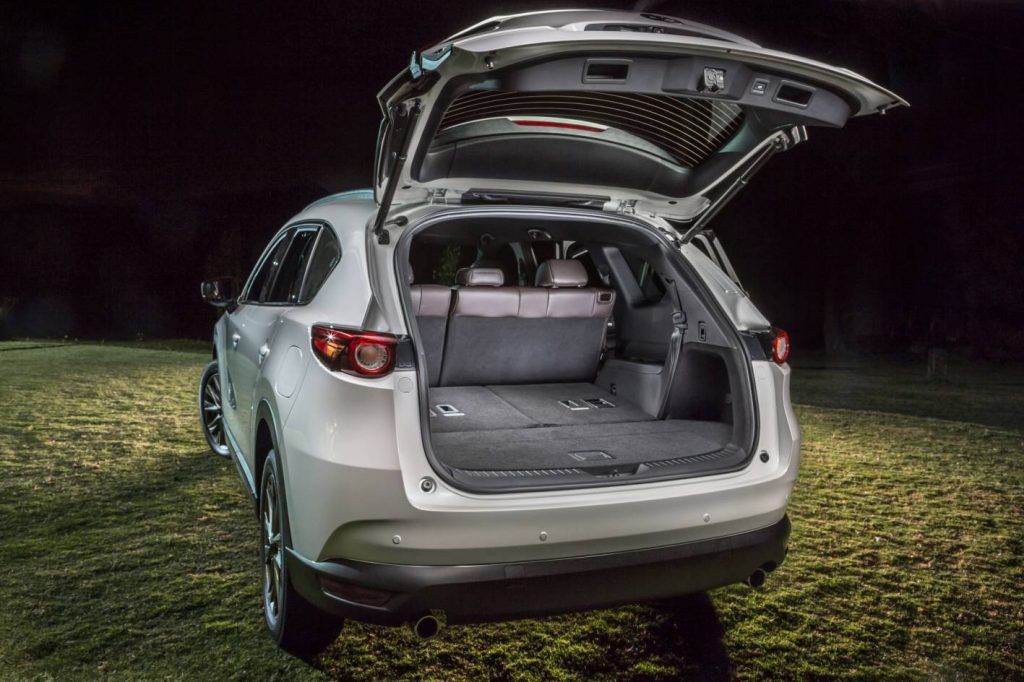
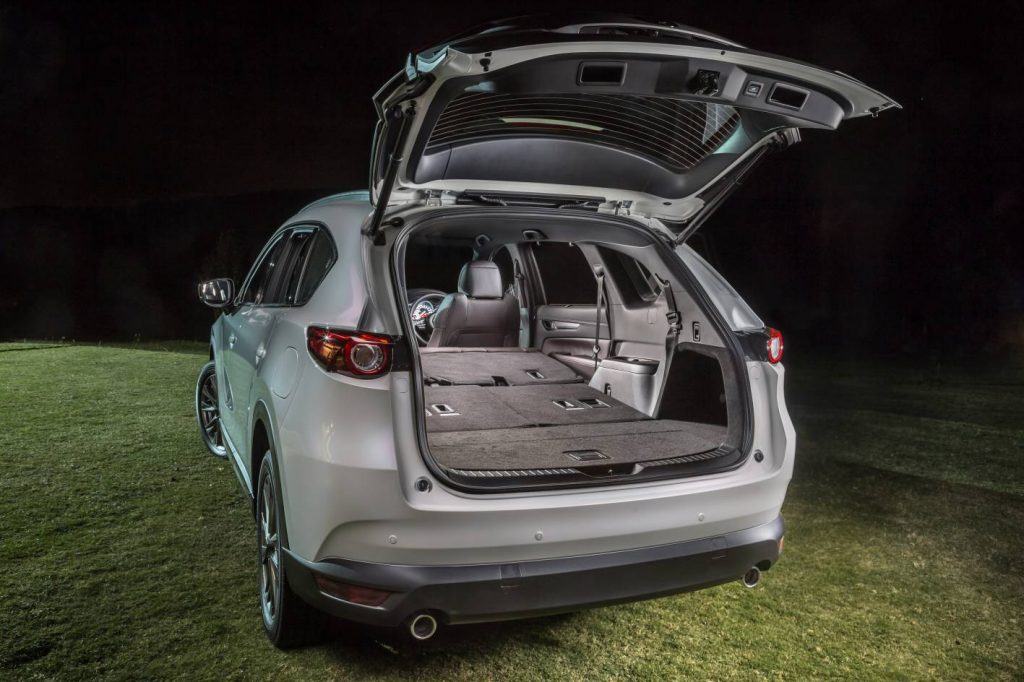
In terms of its interior size, the CX-8 has 209 litres of cargo space behind the third-row seats and this rises to 242 litres when the handy under-floor cubby is used.
Drop the third-row seat-backs down and you’ve got 742 litres – around 70 litres less than the big CX-9 but still generous. Golf clubs, prams, kids’ bikes and other odd-shaped cargo is swallowed with ease, and the relatively high loading point means a bit of lifting but less bending. If you have to regularly fit and remove child seats, you’ll appreciate the ISOfix mounting points on the two outboard seats, and again, the tall stance of the CX-8 makes getting them in and out easier than in lower-mounted vehicles.
Drop the second-row seat-backs and you’ve got 1727 litres to play with.
The turbo-diesel engine is right up there with the best from Europe and it delivers heaps of lovely torque while delivering that frugal 5.7L/100km combined fuel-consumption figure.
The figure is helped by the car’s idle/stop system – a feature I greatly dislike on all cars to which it is fitted – and I wish the CX-8 (and the rest of them) would remember that I turn it off whenever I’m behind the wheel. (Ian’s not alone – most people dislike start/stop and many disable it. However, despite switching it off, Ian still managed a 5.7L/100km fuel consumption figure, precisely that claimed by Mazda, so we have to ask if stop/start is as efficient as we are led to believe. Our opinion is that it is a system that helps manufacturers meet more stringent fuel consumption figures, but is of little value to motorists in the real world – EDITOR)
NVH improvements hide diesel origins
Mazda engineers continue to work diligently on improving the noise, vibration and harshness credentials of all the company’s vehicles and it certainly shows with the CX-8.
Such is the car’s overall refinement, family members and friends who I chauffeured during my week with the test car could not believe it was a diesel.
The combination of beautifully shaped, supportive seats, a height- and reach-adjustable leather-wrapped multi-function steering wheel and adequate manual seat adjustment means the driver can quickly dial in the perfect driving position.
The engine is mated with a conventional, six-speed torque-converter automatic transmission and it’s a very happy marriage.
While I’m a sucker for steering-wheel-mounted paddles, I have to admit that their omission in the CX-8 Sport does not really diminish the driving pleasure or fun – especially with all that torque.
And anyway, you can still do manual shifts with the console-mounted shifter.
In terms of the CX-8’s ride, it feels a tad less sporty and firm than the CX-5 and because of this the car felt more comfortable on the rougher stuff.
Steering is beautifully weighted and unless you push the car really hard through tight corners, it’s hard to tell it’s a front-wheel driver. And let’s face it, if you’re pushing hard through corners, you’re perhaps doing it in the wrong vehicle.
Some things to like, some not so much
Like all cars, there are things we like and things we don’t like so much.
First of all, Mazda has finally joined the five-year/unlimited kilometre warranty club.
Secondly, its sharp pricing (especially for an oiler) and its frugal and torquey turbo-diesel engine add greatly to the bottom-line attraction.
Like all Mazda models, the CX-8 has a classy interior and excellent build quality.
On the negative side, there is a space-saver spare and while there is still no Apple CarPlay or Android Auto, by year’s end you’ll be able to retro-fit these … at a yet-to-be-announced price.
I still find the MZD Connect system still a bit frustrating and there are no third-row ventilation outlets.
A tough choice
Finally, Mazda has seen the light and slipped a turbo-diesel engine under the bonnet of a (relatively) large SUV.
For Mazda customers who are in the market for either a CX-9 or a CX-8, it’s going to be a bit of a toss-up … frugal diesel fuel economy with less space or a thirstier, more-roomy (in every way) vehicle.
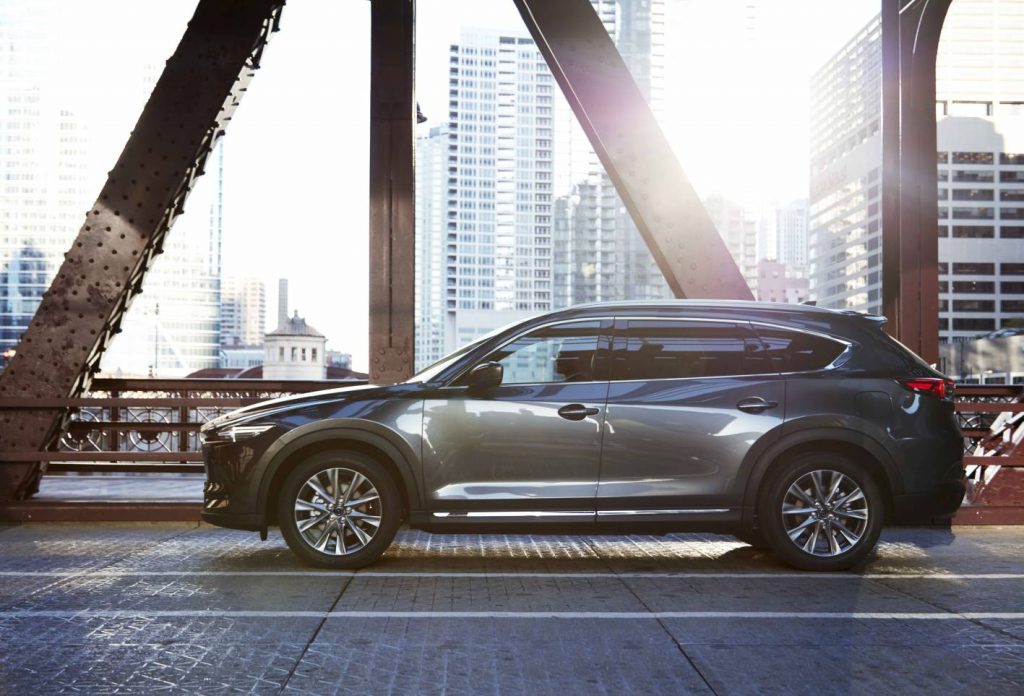
Me? I’m not usually a fence-sitter but on this occasion I think I am.
I’m a great fan of both the CX-9’s 420Nm turbo-petrol engine and the CX-8’s 450Nm turbo-diesel and you certainly can’t separate the two vehicles on the basis of standard kit, technology or safety.
On that basis, fuel-economy aside, it probably comes down to whether you think size matters.

